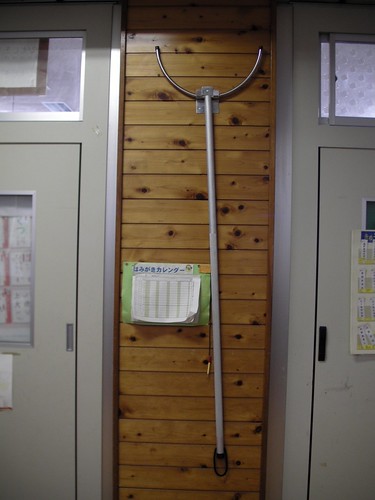Sunday, November 03, 2013
Who Needs Guns?
These two pronged forks are attached to the wall of Japanese schools for use in case someone where to come into the school and attempt to kill children.
Since Japan is largely gun free, and swords are likewise restricted by law, the most dangerous weapon that Japanese can get their hands upon is usually a knife. A man, with mental illness, did however break into a Japanese classroom and kill several children with a knife. Mamoru Takuma, since executed by hanging, went on the rampage in Ikeda primary school in Osaka, fatally stabbing 8 children and wounding 15 more, reportedly as a way of having himself killed and exacting revenge on a departed girlfriend.
So at least since that time, these two pronged forks, called sasumata, are kept in schools to enable the teachers to tackle knife wielders by trapping their torso in the prong.
They are especially effective if used by several people from several directions at once, and date back to the Edo Period when likewise guns and swords were illegal among the general population, and the Japanese attempted to apprehend criminals uninjured. These Edo Period sasumata were however equipped with blades or spikes at the U end of the fork to help prevent the criminal from grasping the pole (sasumata).
It is surprising that Japan is not only gun-less but fairly blade-less. Daggers, which are defined as two sided blades, are illegal longer than 5.5cm cm. Most murders are carried out using kitchen knives of which there are plenty. But despite the fact that there are no restrictions on the purchase of one sided kitchen knives, and that they can be had for 1 dollar or more, I know of very few law abiding Japanese that carry or possess blades for use a a self defence weapon. Even a 5.5cm knife would be a significant deterrent if someone came at you with a kitchen knife. The long kitchen knife wielder would win, the victim would probably die, but the attacker would be deterred and sufficiently wounded such that they would not be able to attack many more people. I think that if the victims had small self defence blades, then an attacker would be hard pressed to kill three people since after killing two he would have at least two 5cm wounds in his body.
So why don't Japanese people carry a small self defence blade? Why aren't their such blades in schools?
In line with my usual interpretation of Japan, I suggest that the reason is cultural. There has long been a taboo on blood in Japan. Wounding anyone, especially in such a way as to penetrate their skin and draw blood is an anathema to vast majority of Japanese. There are no guns, few knives, and though many Japanese are karate experts it is even far harder to get yourself beaten up. Why are the Japanese generally so non-violent? There is quite a lot of white collar crime, such as fraud, cartels and other corruption which, though there are a form of violence, are often argued to be forgiveable. I think that the difference lies, as usual, in a difference in what people are thought to be. In the West the body is something that contains the mind. A wound to the body leaves the person intact. In Japan however, as an extension of animism, I believe people identify with their bodies, particularly with their bodily image. Thus to stab someone, to penetrate another's skin, is to penetrate their person. It is a much weightier act, of far greater violence. To deceive another person is however often even a good idea (uso mo houben 嘘も方便) since, contra Westerners, the Japanese do not identify with their self-narrative and words are the mere fluff that allows bodies as people to make jokes to each other.
Labels: culture, japan, japanese culture, 日本文化
This blog represents the opinions of the author, Timothy Takemoto, and not the opinions of his employer.

